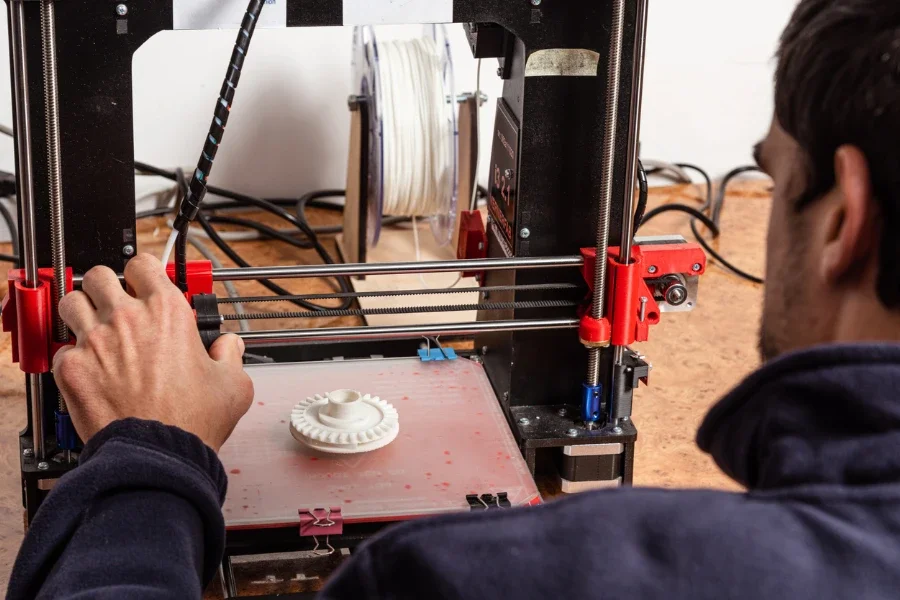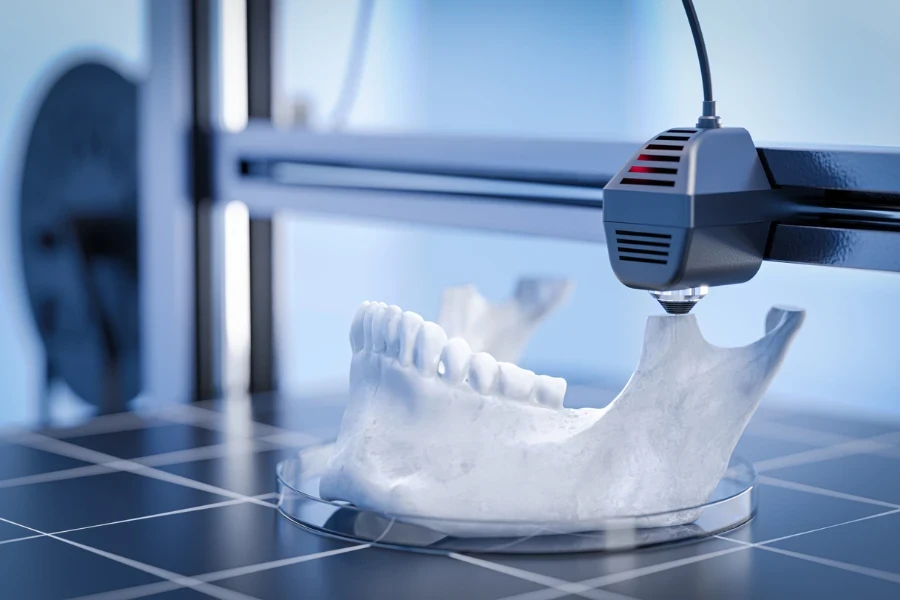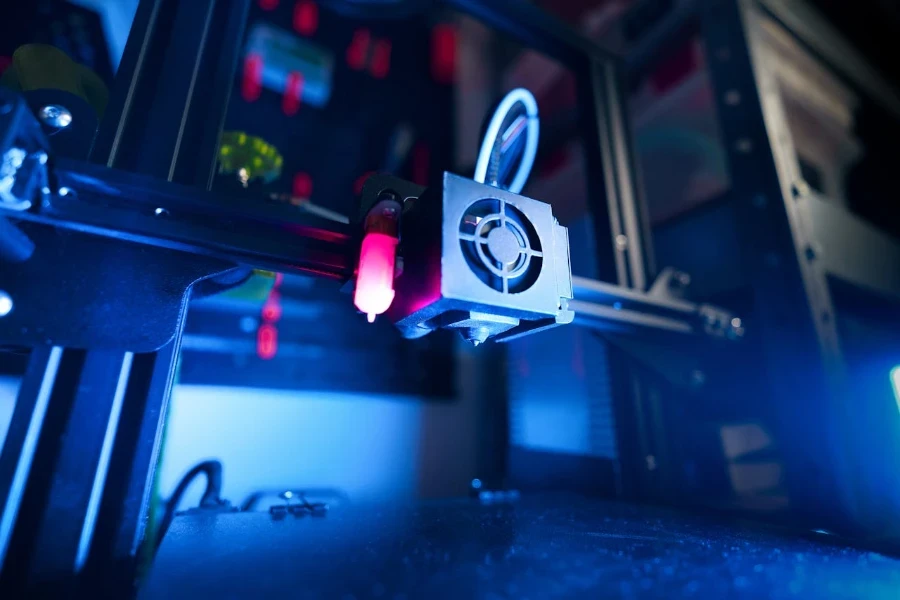3D printing has emerged as a game-changer in many industries in the last several years. Businesses specializing in selling technology products, such as electronics retailers or online distributors, can expand their offerings by including 3D printers. We are here to help you start selling 3D printers, but if you’re brand new to 3D printing and want to learn more about what it is, how it works, and its benefits, check out this beginner’s guide first.
Table of Contents
Understanding the 3D printing market
Understanding the versatile applications of 3D printers
Businesses best suited for adding 3D printers to their product lineup
Key factors to consider when purchasing 3D printers
Final thoughts
Understanding the 3D printing market
According to Grandview Research, the global 3D printing market was valued at over US$ 20 billion in 2023 and is projected to grow at a compound growth rate (CAGR) of 23.5% between 2024 and 2030. In 2023, North America emerged as the dominant force, commanding over 33% of the global revenue, signaling a robust foothold in this transformative technology.
This growth is fueled by technological advancements, expanding applications across industries, and the growing demand for customized products. Let’s dive deeper into what segments of 3D printing are seeing the most significant growth, according to Grandview.
The industrial printer segment led the market and accounted for an impressive 76% share of the global revenue in 2023. This dominance stems from widespread adoption in heavyweight industries like automotive, electronics, aerospace and defense, and healthcare. The versatility of industrial printers finds expression in prototyping, designing, and tooling, serving as indispensable assets across these sectors.
Within the industrial realm, the prototyping segment emerges as the frontrunner, accounting for over 54% of the global revenue in 2023. This surge is fueled by the widespread embrace of prototyping processes across many industries. Automotive and aerospace industries, in particular, leverage prototyping to meticulously design and develop intricate parts, components, and complex systems, heralding a new era of precision engineering.
Meanwhile, the desktop 3D printing segment caters to a diverse array of verticals, including education, fashion, jewelry, and dental. This democratization of 3D printing technology opens doors to innovative applications, from manufacturing imitation jewelry and miniatures to crafting bespoke clothing and apparel. The convergence of creativity and technology in these sectors promises to reshape industries and redefine consumer experiences.
As the 3D printing landscape continues to evolve and expand, businesses across the globe are poised to harness its transformative potential. With endless possibilities awaiting exploration, the journey into the world of 3D printing is only just beginning, promising a future where imagination knows no bounds.
Understanding the versatile applications of 3D printers

When considering adding 3D printers to your product lineup, it’s essential to understand the diverse range of applications these machines serve. By gaining insight into the most common uses of 3D printers, you can better identify your target audience and tailor your offerings to meet their needs.
Here are some of the most prevalent applications of 3D printing technology:
1. Prototyping and product development
3D printing enables rapid prototyping of concepts and designs, allowing businesses to iterate quickly and cost-effectively. From concept models to functional prototypes, 3D printers facilitate the validation of ideas and the refinement of product designs before full-scale production.
- Target Audience: Product designers, engineers, and manufacturing companies.
2. Customized manufacturing and personalization
3D printing empowers businesses to offer customized and personalized products to their customers. Whether personalized accessories, customized smartphone cases, or bespoke jewelry, 3D printers enable on-demand manufacturing of unique and individualized items, catering to niche markets and enhancing customer satisfaction.
- Target Audience: Retailers, jewelry designers, and consumer goods manufacturers.
3. Medical and healthcare applications

In the healthcare sector, 3D printing is revolutionizing patient care by enabling the production of customized medical implants, prosthetics, and surgical guides. From patient-specific anatomical models for surgical planning to 3D-printed prosthetic limbs tailored to individual patients, this technology drives innovation and improves outcomes in the medical field.
- Target Audience: Hospitals, medical device manufacturers, and prosthetics clinics.
4. Education and research

3D printing has become an invaluable tool for educators and researchers, providing hands-on learning experiences and facilitating scientific exploration. From teaching complex concepts in engineering and design to conducting experiments and creating educational models, 3D printers foster creativity, innovation, and interdisciplinary learning across various disciplines.
- Target Audience: Educational institutions, research laboratories, and STEM educators.
5. Architectural modeling and visualization

Architects and designers leverage 3D printing technology to create detailed architectural models and visualizations, enabling clients to better understand proposed designs and spatial concepts. Whether scale models of buildings, urban planning prototypes, or intricate landscape designs, 3D printers streamline the design process and enhance communication in the architecture and construction industry.
- Target Audience: Architecture firms, urban planners, and construction companies.
6. Aerospace and automotive engineering

3D printing plays a crucial role in the aerospace and automotive sectors, where lightweight, high-performance components are in demand. From aircraft parts and engine components to custom automotive prototypes and tooling, 3D printers enable the production of complex geometries and optimized designs that enhance performance, reduce weight, and improve fuel efficiency.
- Target Audience: Aerospace companies, automotive manufacturers, and engineering firms.
Businesses best suited for adding 3D printers to their product lineup
Not every business is primed to incorporate 3D printers into their product lineup. However, certain types of companies can benefit greatly from offering 3D printers to their customers.
Here’s a glimpse into the types of businesses that should consider adding 3D printers to their product lineup:
1. Technology retailers and distributors
Businesses specializing in selling technology products, such as electronics retailers or online distributors, can expand their offerings by including 3D printers. These retailers already have an established customer base interested in innovative tech products and can capitalize on the growing demand for 3D printing technology.
2. Educational suppliers
Suppliers of educational materials and equipment, including STEM kits, robotics, and science supplies, can enhance their product offerings with 3D printers. These businesses cater to schools, universities, and educational institutions, providing them with the tools and resources to incorporate 3D printing into their curriculum and programs.
3. Industrial equipment suppliers
Companies that supply industrial equipment and machinery to manufacturing, engineering, and construction sectors can diversify their product portfolio with 3D printers. These businesses already serve clients in industries where 3D printing is increasingly utilized for prototyping, tooling, and custom manufacturing applications.
4. Specialty retailers and hobby shops
Specialty retailers and hobby shops catering to niche markets, such as model-making, cosplay, and DIY enthusiasts, can attract customers by offering 3D printers and related accessories. These businesses cater to hobbyists and enthusiasts passionate about creating and building projects using 3D printing technology.
5. Business solutions providers
Companies that provide business solutions, including office equipment, software, and consulting services, can incorporate 3D printers into their offerings. These businesses serve a diverse range of clients across industries and can provide value-added services such as consulting, training, and technical support for implementing 3D printing solutions.
Key factors to consider when purchasing 3D printers

Expanding your product lineup to include 3D printers can be a strategic move. However, it’s crucial to carefully evaluate several factors to ensure you choose the right 3D printers that align with your business goals and cater to the needs of your target customers.
Here are the key factors to consider:
- Market demand and trends: Begin by researching market trends to understand the current and projected demand for 3D printers. Analyze growth projections, emerging applications, and industry trends to identify lucrative opportunities. Determine which customer segments are most likely to purchase 3D printers based on their needs, preferences, and purchasing behavior.
- Product features and specifications: Prioritize quality and performance when evaluating potential 3D printers. Assess factors such as print quality, speed, resolution, and reliability to ensure they meet the standards expected by your customers. Consider the compatibility of 3D printers with various materials, software, and accessories to provide versatility and flexibility. Additionally, assess the user-friendliness of 3D printers, including setup, operation, and maintenance, to cater to customers with varying levels of expertise.
- Price and value proposition: Conduct a cost-benefit analysis to compare the upfront cost, total cost of ownership, and potential return on investment (ROI) of different 3D printers. Set competitive pricing while maintaining healthy profit margins for your business. Ensure that the chosen 3D printers offer a compelling value proposition to customers.
- Supplier and brand reputation: Choose reputable and reliable suppliers or manufacturers with a track record of delivering high-quality products and excellent customer support. Consider partnering with well-known brands in the 3D printing industry to leverage their brand reputation and credibility.
- Customer support and service: Prioritize suppliers that offer comprehensive technical support, training, and troubleshooting resources to assist your customers. Verify the warranty coverage and after-sales service provided by the supplier to address any issues or defects that may arise after purchase.
- Marketing and sales strategy: Develop targeted marketing campaigns and sales strategies to promote your 3D printers to specific customer segments. Highlight the unique features, benefits, and applications of your 3D printers. Additionally, explore partnerships with complementary businesses to expand your reach and distribution channels.
- Scalability and future growth: Select 3D printers offering scalability and upgrade options to accommodate future technological advancements and evolving customer needs. Stay informed about emerging trends and innovations in the 3D printing industry to adapt your product lineup and business strategy accordingly.
- Regulatory compliance and standards: Ensure that the 3D printers you offer comply with relevant regulations, certifications, and safety standards to meet legal and industry requirements. Consider ethical and environmental factors, such as sustainability practices and responsible sourcing, when choosing 3D printers and suppliers.
By carefully evaluating these factors, businesses can make informed decisions about which 3D printers to add to their product lineup, ultimately enhancing their competitiveness, meeting customer demands, and driving business growth in the dynamic 3D printing market.
Final thoughts
Now that you’ve determined you want to add 3D printers to your product lineup to take advantage of this growing market, it’s time to start thinking about your target audience and what 3D printers you’d like to carry. Check out our list of the top 3D printers in 2024 to help get you started on choosing which models to purchase.



